The Checker Maven
Winter's End

By the time this article appears, winter should be coming to an end in much of North America, and a welcome thing that will be for those who endured repeated blizzards and lasting cold. The coming of spring will bring a huge sigh of relief to winter-weary Americans and Canadians.

Here at our Honolulu editorial office, we too experienced winter cold spells with temperatures that dropped as low as 63 F, though we don't expect much in the way of sympathy from our readers.
But wherever you live, let's celebrate spring together (if you're in the southern hemisphere, let's welcome the advent of fall; we've heard that Australia was mighty hot during some of the austral summer), and let's do it with a challenging checker problem authored long ago by George King.
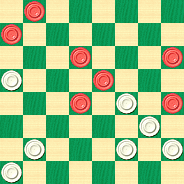
WHITE
White to Play and Draw
W:W29,28,27,25,24,19,13:B20,18,15,12,10,5,1.
Forces are even, but White has a really limited choice of moves and could be in serious difficulty. But, just as you would clear a path through the blizzard's snow, there is a way out of White's predicament here. Can you find it and secure the draw?
Shovel your way through the complications and find the path, then dig your mouse on Read More to see the solution.![]()
See Right With Searight

This month's Checker School lesson considers a position published by the great late 19th century player and analyst, J. Searight. It's a problem with a twist, a surprising move that requires keen "checker vision" to find. Now, the glasses worn by the couple in the photo above are not likely to bestow "checker vision" upon them; the result might be more akin to a headache, so we recommend instead that you put on a set of imaginary lenses of the kind that can enable you to solve the problem position shown below.
WHITE
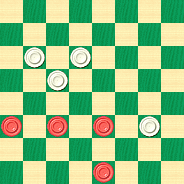
BLACK
Black to Play and Draw
B:W24,23,19,9:B12,11,10,2.
This is something like last month's Checker School entry, but of course small differences matter, and Black can find a draw here if he views the position through the right lens.
Can you see right through this problem, or do you have trouble focusing? Never mind; after you've eyeballed it for a while, click on Read More for a clear view of the solution, two sample games, and descriptive notes.![]()
Another Heffner Gem
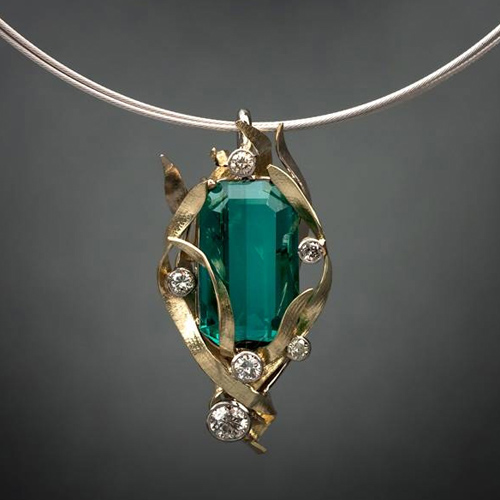
The term "gem" is often used to describe a particularly elegant checker problem; we've discussed this at various times and at various length in previous editions of The Checker Maven. What qualifies as a "gem" is highly subjective, and seems to fall into the "I'll know it when I see it" category. Now, there is no doubt the elegant piece of jewelry shown above is a "gem" in more than one sense of the word. Whether or not today's excerpt from Willie Ryan's Tricks Traps & Shots of the Checkerboard falls into the "gem" category is something you'll have to decide for yourself, after Willie sets the stage for us.
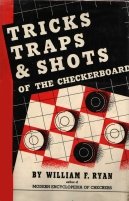
"Back in 1925, when I was learning checkers the hard way, I played the following game in a 30-game match with Mike Lieber, of Detroit, then one of the country's leading players:
| 10-14 | 27-24 | 11-16 | |
| 22-17 | 3- 7 | 24-20 | |
| 6-10 | 24-19 | 17-21 | |
| 17-13 | 11-16 | 20-11 | |
| 1-6 | 20-11 | 7-i6 | |
| 25-22 | 8-24 | 26-22 | |
| 14-17 | 28-19 | 16-20---A,1 | |
| 21-14 | 4-8 | 22-17 | |
| 9-25 | 22-18 | 20-24 | |
| 29-22 | 14-17 | 18-14 | |
| 10-14 | 32-27 | 2-7, | |
| 24-20 | 8-11 | reaching the | |
| 7-10 | 27-24 | diagrammed | |
| position." |
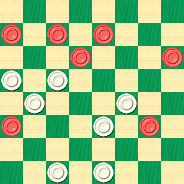
WHITE
White to Play and Win
W:W31,30,23,19,17,14,13:B24,21,12,10,7,6,5.
A---The losing move. 10-14 will insure a draw with a little care."
1---It seems somewhat unintuitive that going in for a king would lose, yet it indeed does. We ran a computer analysis, and it was interesting to see the computer start out by evaluating this as a weak move, but, as it ran deeper and deeper searches, downgrading the move to a highly probable loss. We can easily understand how a human player, even of Mr. Ryan's strength, could make this move---Ed.
We find Willie's comment, by the way, about "learning checkers the hard way" to be very revealing: if Willie learned "the hard way" then we suspect that all the rest of us learn the same way. Alas, there is no royal road to checker success--- but where would the fun be if there was?
In any event, see if you can find that sparkling, precious winning way, and then click on Read More to see all the facets of the solution.![]()
How to Win at Checkers

Today we're at long last presenting you with a newly-typeset electronic edition of one of the most complete books on the basics of the game ever published, Fred Reinfeld's How to Win at Checkers. We've previously written about Mr. Reinfeld and published a review of his book. Now, thanks to the generosity of Mr. Reinfeld's estate, who kindly authorized this edition, the book is available instantly, worldwide, and entirely free of charge. You can download it here.
Our further thanks and appreciation go out to anonymous checkerist "Mr. T." who scanned and edited the initial drafts of the new edition, reset the diagrams, and passed the results along to us.

To introduce you to the book, we've picked out a problem situation and present it below. (The book doesn't really have problems per se, just examples; but you can make your own problems by trying to solve the diagrams before looking at the text below them.) Here's a run-up to the diagram.
| BLACK | WHITE | |
| 1. | 10-15 | 22-18 |
| 2. | 15x22 | 25x1 |
| 3. | 6-10 | 29-25 |
| 4. | 10-15---A | 25-22---B |
A---An inferior move played to set a trap (usually bad strategy). 11-15 was correct.
B---Loses; White should have played 18-14 to keep the advantage
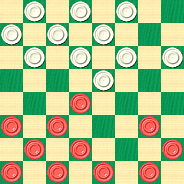
BLACK
Black to Play and Win
B:W32,31,30,28,27,26,24,23,22,21,18:B15,12,11,9,8,7,5,4,3,2,1.
We invite you to solve the problem, and then download the book to look up the solution (it is found under Diagram 33). We hope you enjoy and benefit from our new version of this classic work. ![]()
